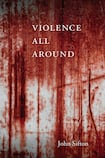
Documenting wartime human rights violations used to be my job. Over a good few years, working for the United Nations, I witnessed the most appalling acts of cruelty and inhumanity. Often I arrived on a scene to find mutilated bodies, wounded or deeply traumatised survivors and smouldering buildings.
A few times I was a direct witness to atrocity, like the summary execution of "rebels" in the streets of Freetown, the capital of Sierra Leone. In that country the perpetrators were sometimes just teenagers, many of whom had themselves been abducted years beforehand. I used to speak with these kids, who were often armed to the teeth and high on drugs, to try to persuade them to release kidnapped children.
More than once I came close to being killed, sometimes by being in the wrong place at the wrong time but more often for such stupid reasons as driving a faulty jeep or begging a lift on an ancient helicopter.
My main job was to chronicle what was going on, frame it in terms of the relevant international human-rights law and get the reports up the line to UN decisionmakers in New York and Geneva. The work sometimes seemed futile, even cruel, fuelling false expectations among people who co-operated with us.
Often it felt as if no one cared. My own boss when I worked in Bosnia, the former prime minister of Poland Tadeusz Mazowiecki, resigned in protest at the ignoring of his warning about the imminent massacre at Srebrenica. I never quit, but I did have moments of near despair. I recall sitting in tears on a veranda in Freetown, listening to the worsening artillery fire in nearby hills at a moment when the world seemed to have interest in only one conflict: the one far away in Kosovo.
What kept my colleagues and I going were the small achievements: protecting some people simply because of our presence, improving conditions in detention facilities, helping to ensure that food and aid were distributed equitably, seeking to keep the situation of innocent victims of war to the forefront of peacemakers’ attention.
The chronicling also had its successes, especially for the delivery of postconflict justice. It was very satisfying for me many years later to present my reports and give evidence at the trials in which the Liberian president Charles Taylor and others were convicted of crimes against humanity.
Flooding back
All the memories came flooding back while reading John Sifton’s book,
Violence All Round
. Working for the advocacy group
Human Rights Watch
, he has spent many years investigating atrocities in places such as
Afghanistan
and Kosovo, and his book chronicles the common experience of human-rights monitors everywhere. At this level alone the book is of value. Too little has been written about human-rights field workers, and Sifton performs a service in describing this little-known or -understood professional world.
Sifton's book, however, seeks to go much further. His experiences have propelled him to confront the nature of violence and to question whether in its face human-rights work can have any utility. In his exploration of these issues he weaves a remarkable blend of storytelling, philosophical and theological reflection, history, literature, personal reminiscence and political science. Notably, he invokes the writings of his grandfather Reinhold Niebuhr, the distinguished American philosopher.
For Sifton violence is ubiquitous. He argues convincingly that “human history, literature, psychology and popular culture – in almost every region and tradition – spill over with violence in one form or another”. For him violence “is all around us, not only in the horrors of war and terrorism but in the basic social structures of police courts and security guards”.
Some of the arguments may surprise. He writes of the “violence of non-violence”, rejecting the notion of a pure pacifism, as, he says, survival in a political and social world requires that even those who live lives of “cloistered pacifism” must be supported or protected by the political communities in which they exist, “with all their violent attendants”. From all of this he concludes that as violence is unavoidable it must be worked with, “met, head on, redirected or absorbed”.
It is on this basis that Sifton then seeks to find a rationale for his human-rights work. He explains how he had once thought that its task was to awaken the giants who might unleash violence (not just bloody force but also coercion and sanction) against the bad people. Ultimately he rejected this understanding, first because it implicates the human-rights movement in an unacceptable solicitation of violence and second because, in the nature of human-rights abuses, perpetrated by the powerful against the weak, it is the giants themselves who need to be restrained.
Sifton determines from all of this that the essential role of human-rights advocacy is to tug at the conscience of the giant, to seek to influence his behaviour through a process of naming and shaming.
It is hard not to feel somewhat let down by Sifton’s conclusion. It seems reductionist, tailored to the needs of his narrative. Naming and shaming is at the heart of what we do, but it is far from all. Sifton’s concern not to awaken giants results in his truncating of the legitimate and useful role of human rights or the range of its tools. I would have welcomed more attention on how the invocation of rights can empower civil society, contribute to the shaping of international peacekeeping interventions, support criminal justice and inform development programmes. Most disappointingly, Sifton does not engage with the role of human rights in preventing abuses in the first place. Here I would take issue with his rejection of the value of human-rights education and his assertion that belief in its potency is “naive or academic” – a judgment that is at odds with experience and appears condescending.
Riveting
Sifton’s failure to convince me of his overall thesis does not detract much from my enjoyment of his writing. Taken as separate essays, the chapters are usually riveting: elegantly written, informative and displaying an impressive breadth of learning. Only very occasionally does a lack of specialist understanding show itself – his historical examination of the religion-violence nexus is a potted history that fails to employ the tools of theological and religious research.
That section also contains minor errors, such as a mention of a “joint Mass” by Pope John Paul II and Patriarch Bartholomew that never took place (Bartholomew attended a Mass celebrated by John Paul) and a description of Franciscans as monks rather than as friars, or, as St Francis termed them, brothers. But these are minor quibbles, and Sifton’s book stands as a thought-provoking reflection in which he stays true to his motivation to “produce something positive and somehow reverse the greater negative sign that violence represents”.
Michael O’Flaherty is professor of human-rights law and director of the Irish Centre for Human Rights at NUI Galway










